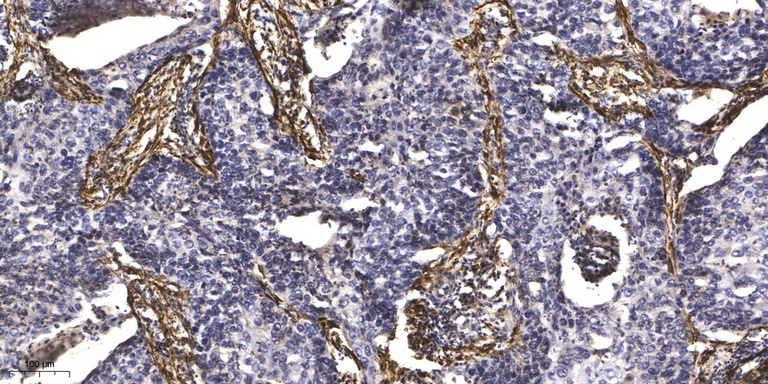Centriolin Polyclonal Antibody
- Catalog No.:YT0854
- Applications:IHC;IF;ELISA
- Reactivity:Human;Rat;Mouse;
- Target:
- Centriolin
- Gene Name:
- CCP110
- Protein Name:
- Centriolar coiled-coil protein of 110 kDa
- Human Gene Id:
- 9738
- Human Swiss Prot No:
- O43303
- Mouse Swiss Prot No:
- Q7TSH4
- Immunogen:
- The antiserum was produced against synthesized peptide derived from human CEP110. AA range:850-900
- Specificity:
- Centriolin Polyclonal Antibody detects endogenous levels of Centriolin protein.
- Formulation:
- Liquid in PBS containing 50% glycerol, 0.5% BSA and 0.02% sodium azide.
- Source:
- Polyclonal, Rabbit,IgG
- Dilution:
- IHC 1:100 - 1:300. ELISA: 1:40000.. IF 1:50-200
- Purification:
- The antibody was affinity-purified from rabbit antiserum by affinity-chromatography using epitope-specific immunogen.
- Concentration:
- 1 mg/ml
- Storage Stability:
- -15°C to -25°C/1 year(Do not lower than -25°C)
- Other Name:
- CCP110;CEP110;CP110;KIAA0419;Centriolar coiled-coil protein of 110 kDa;Centrosomal protein of 110 kDa;CP110;Cep110
- Molecular Weight(Da):
- 113kD
- Background:
- function:Necessary for centrosome duplication. Collaborates with CEP97, being involved in the suppression of a cilia assembly program. Required for correct spindle formation and has a role in regulating cytokinesis and genome stability via cooperation with CALM1 and CETN2.,induction:Up-regulated during the transition from G1 to S phase of the cell cycle. The highest levels are observed in S phase, after which the levels decrease markedly.,PTM:Phosphorylated by CDKs.,subunit:Interacts with CALM1, CETN2 and CEP97.,tissue specificity:Highly expressed in testis. Detected at intermediate levels in spleen, thymus, prostate, small intestine, colon and peripheral blood leukocytes.,
- Function:
- function:Necessary for centrosome duplication. Collaborates with CEP97, being involved in the suppression of a cilia assembly program. Required for correct spindle formation and has a role in regulating cytokinesis and genome stability via cooperation with CALM1 and CETN2.,induction:Up-regulated during the transition from G1 to S phase of the cell cycle. The highest levels are observed in S phase, after which the levels decrease markedly.,PTM:Phosphorylated by CDKs.,subunit:Interacts with CALM1, CETN2 and CEP97.,tissue specificity:Highly expressed in testis. Detected at intermediate levels in spleen, thymus, prostate, small intestine, colon and peripheral blood leukocytes.,
- Subcellular Location:
- Cytoplasm, cytoskeleton, microtubule organizing center, centrosome, centriole . Cytoplasm, cytoskeleton, microtubule organizing center, centrosome . Cytoplasm, cytoskeleton, cilium basal body . Recruited early and then associates with the growing distal tips. Recruited to the mother centriole by KIF24 (PubMed:21620453). Removed from centrioles by TTBK2, leading to initiation of ciliogenesis and localizes only to the daughter centriole in ciliated cells. In cytotoxic T lymphocytes remains associated with the mother centriole during docking of the centrosome at the immunological synapse upon target contact (By similarity). Recruited at the distal end of the mother centriole by MPHOSPH9 (PubMed:30375385). .
- Expression:
- Highly expressed in testis. Detected at intermediate levels in spleen, thymus, prostate, small intestine, colon and peripheral blood leukocytes.
- June 19-2018
- WESTERN IMMUNOBLOTTING PROTOCOL
- June 19-2018
- IMMUNOHISTOCHEMISTRY-PARAFFIN PROTOCOL
- June 19-2018
- IMMUNOFLUORESCENCE PROTOCOL
- September 08-2020
- FLOW-CYTOMEYRT-PROTOCOL
- May 20-2022
- Cell-Based ELISA│解您多样本WB检测之困扰
- July 13-2018
- CELL-BASED-ELISA-PROTOCOL-FOR-ACETYL-PROTEIN
- July 13-2018
- CELL-BASED-ELISA-PROTOCOL-FOR-PHOSPHO-PROTEIN
- July 13-2018
- Antibody-FAQs
- Products Images

- Immunohistochemical analysis of paraffin-embedded human Squamous cell carcinoma of lung. 1, Antibody was diluted at 1:200(4° overnight). 2, Tris-EDTA,pH9.0 was used for antigen retrieval. 3,Secondary antibody was diluted at 1:200(room temperature, 45min).



